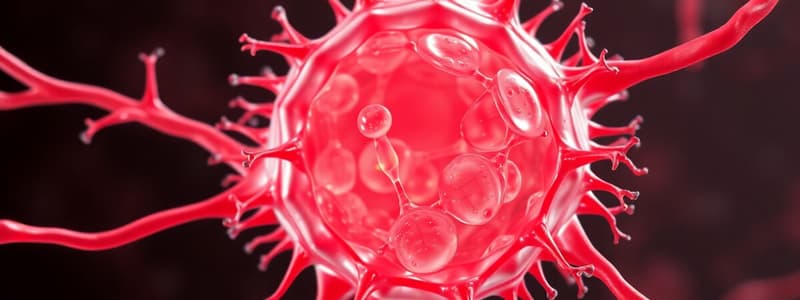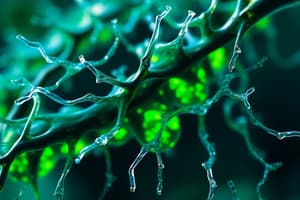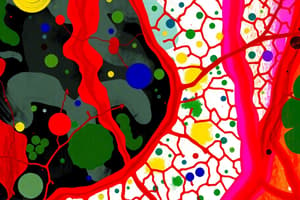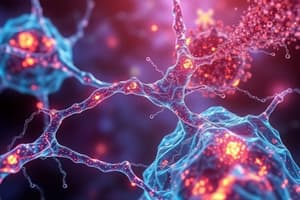Podcast
Questions and Answers
What structural change occurs in integrins upon ligand binding?
What structural change occurs in integrins upon ligand binding?
Integrins adopt an extended conformation that exposes binding sites for cytoskeleton attachment.
Define Outside-In signaling in the context of integrin activation.
Define Outside-In signaling in the context of integrin activation.
Outside-In signaling refers to the process where ligand binding activates integrins, leading to an extended conformation.
How does Inside-Out signaling affect integrin activation?
How does Inside-Out signaling affect integrin activation?
Inside-Out signaling activates talin, which alters the conformation of integrins to increase their affinity for ligands.
What role does talin play in integrin activation?
What role does talin play in integrin activation?
Why is the interaction between integrins and the cytoskeleton important?
Why is the interaction between integrins and the cytoskeleton important?
What role do cadherins play in cell adhesion?
What role do cadherins play in cell adhesion?
What are focal adhesions in relation to integrin-based adhesion?
What are focal adhesions in relation to integrin-based adhesion?
How do catenins contribute to the function of classical cadherins?
How do catenins contribute to the function of classical cadherins?
Describe the effect of chemokine receptor activation on integrin function.
Describe the effect of chemokine receptor activation on integrin function.
What is the function of gap junctions in cell communication?
What is the function of gap junctions in cell communication?
What is the relationship between integrin pairs and their function?
What is the relationship between integrin pairs and their function?
What distinguishes the immunoglobulin superfamily of cell adhesion molecules from cadherins?
What distinguishes the immunoglobulin superfamily of cell adhesion molecules from cadherins?
Explain the significance of integrins in cell-matrix adhesion.
Explain the significance of integrins in cell-matrix adhesion.
What role do vinculin and F-actin play in integrin-mediated adhesion?
What role do vinculin and F-actin play in integrin-mediated adhesion?
Describe the role of selectins in leukocyte recruitment.
Describe the role of selectins in leukocyte recruitment.
How do tight junctions contribute to cell adhesion in epithelial tissues?
How do tight junctions contribute to cell adhesion in epithelial tissues?
In synapse formation, what role do adhesion molecules play?
In synapse formation, what role do adhesion molecules play?
What are transmembrane proteoglycans and their function?
What are transmembrane proteoglycans and their function?
Explain the significance of L-selectin in lymphocyte homing.
Explain the significance of L-selectin in lymphocyte homing.
What is the importance of weak interactions facilitated by selectins during neutrophil recruitment?
What is the importance of weak interactions facilitated by selectins during neutrophil recruitment?
What is the role of the extracellular matrix (ECM) in multicellular organisms?
What is the role of the extracellular matrix (ECM) in multicellular organisms?
How do stable and transient cellular adhesions differ in their functions?
How do stable and transient cellular adhesions differ in their functions?
What is the function of tight junctions in epithelial cells?
What is the function of tight junctions in epithelial cells?
Name two types of cellular junctions and their primary roles.
Name two types of cellular junctions and their primary roles.
What types of connections do integrins facilitate between cells and the extracellular matrix?
What types of connections do integrins facilitate between cells and the extracellular matrix?
How do cadherins contribute to cell adhesion?
How do cadherins contribute to cell adhesion?
What role do selectins play in cellular adhesion?
What role do selectins play in cellular adhesion?
Explain the significance of gap junctions in cellular communication.
Explain the significance of gap junctions in cellular communication.
In what way do cell adhesion molecules (CAMs) enhance cellular signaling?
In what way do cell adhesion molecules (CAMs) enhance cellular signaling?
What is the overall importance of cell adhesion in multicellular organisms?
What is the overall importance of cell adhesion in multicellular organisms?
What is the role of E-selectin during inflammation?
What is the role of E-selectin during inflammation?
How do P-selectins contribute to the process of hemostasis?
How do P-selectins contribute to the process of hemostasis?
Describe the function of syndecans in cellular interactions.
Describe the function of syndecans in cellular interactions.
What type of junctions are hemidesmosomes, and what do they connect?
What type of junctions are hemidesmosomes, and what do they connect?
What are integrins and their primary role in cellular function?
What are integrins and their primary role in cellular function?
How does inflammation affect the expression of selectins?
How does inflammation affect the expression of selectins?
Identify two functions of integrins in the context of cell adhesion.
Identify two functions of integrins in the context of cell adhesion.
What types of cells typically express syndecans?
What types of cells typically express syndecans?
What regulates the upregulation of E-selectin during inflammation?
What regulates the upregulation of E-selectin during inflammation?
Explain the significance of the integrin α6β4 linker proteins.
Explain the significance of the integrin α6β4 linker proteins.
Flashcards
Cadherins
Cadherins
Adhesion proteins that mediate calcium-dependent cell-to-cell adhesion.
Catenins
Catenins
Anchor proteins connecting cadherins to the actin cytoskeleton.
Gap Junctions
Gap Junctions
Channels allowing the transfer of small molecules between cells.
Tight Junctions
Tight Junctions
Signup and view all the flashcards
Immunoglobulin Superfamily
Immunoglobulin Superfamily
Signup and view all the flashcards
Selectins
Selectins
Signup and view all the flashcards
Integrins
Integrins
Signup and view all the flashcards
Cell-cell adhesion at synapse
Cell-cell adhesion at synapse
Signup and view all the flashcards
Leucocyte Rolling
Leucocyte Rolling
Signup and view all the flashcards
Cell Adhesion molecules
Cell Adhesion molecules
Signup and view all the flashcards
Extracellular Matrix (ECM)
Extracellular Matrix (ECM)
Signup and view all the flashcards
Artery function
Artery function
Signup and view all the flashcards
Cell Adhesion
Cell Adhesion
Signup and view all the flashcards
Vein function
Vein function
Signup and view all the flashcards
Cell Junctions
Cell Junctions
Signup and view all the flashcards
Selectins Role
Selectins Role
Signup and view all the flashcards
Syndecans
Syndecans
Signup and view all the flashcards
Desmosomes
Desmosomes
Signup and view all the flashcards
Hemidesmosomes
Hemidesmosomes
Signup and view all the flashcards
Adherens Junctions
Adherens Junctions
Signup and view all the flashcards
Integrin α6β4
Integrin α6β4
Signup and view all the flashcards
Extracellular Matrix (ECM)
Extracellular Matrix (ECM)
Signup and view all the flashcards
Desmosomes
Desmosomes
Signup and view all the flashcards
Tissue definition
Tissue definition
Signup and view all the flashcards
Integrin Activation (Outside-In)
Integrin Activation (Outside-In)
Signup and view all the flashcards
Integrin Activation (Inside-Out)
Integrin Activation (Inside-Out)
Signup and view all the flashcards
Integrin Pairs
Integrin Pairs
Signup and view all the flashcards
Focal Adhesions
Focal Adhesions
Signup and view all the flashcards
Podosomes
Podosomes
Signup and view all the flashcards
Cell-Matrix Adhesion
Cell-Matrix Adhesion
Signup and view all the flashcards
Cytoskeleton Attachment
Cytoskeleton Attachment
Signup and view all the flashcards
Extracellular Matrix
Extracellular Matrix
Signup and view all the flashcards
F-actin
F-actin
Signup and view all the flashcards
Vinculin
Vinculin
Signup and view all the flashcards
Study Notes
Cell Adhesion and Cell Signalling
- Multicellular organisms rely on cell adhesion to each other and the extracellular matrix (ECM) for tissue formation.
- Some adhesive interactions are stable, like the firm adhesion of muscle cells to each other and connective tissue in tendons to transmit force to the skeleton. Other adhesive interactions are more transient, such as leukocytes binding to endothelial cells before extravasation into tissues or cell attachment to the ECM during migration. This includes strong adhesion and less permanent adhesion.
Cellular Adhesion
- Multicellular organisms depend on cell adhesion to form tissues.
- Stable adhesive interactions transmit force (e.g., muscle cells to tendons), resist abrasion (e.g., skin epithelial cells to each other), and hold tissues together.
- Transient adhesive interactions facilitate processes such as leukocyte binding to blood vessel linings for extravasation into tissues.
Cell Junctions
- Cell-cell junctions (adherens junctions, desmosomes) and cell-matrix adhesions (actin-linked, hemidesmosomes) connect cells to each other and the ECM. They are linked to the cytoskeleton to transmit forces.
- Tight junctions (septate junctions) seal gaps between cells.
- Gap junctions allow passage of small molecules and ions between cells, facilitating signalling.
Different Types of Cadherins
- Cadherins are a family of adhesion proteins mediating calcium-dependent homophilic adhesion.
- Different types include classical cadherins (E-cadherin), fat-like cadherins, seven-pass transmembrane cadherins, protein kinase cadherins, desmosomal cadherins, cadherin 23, and protocadherins.
Cell Segregation During Embryonic Development
- Cells expressing different cadherins segregate during embryonic development, forming tissues with specific cell types.
Catenins
- Catenins link classical cadherins to the actin cytoskeleton.
- Extracellular cadherin domains bind together to mediate adhesion.
- Cytoplasmic cadherin domains, via anchor proteins (catenins), link to the actin cytoskeleton. The β-catenin also functions in signal transduction pathways such as the Wnt pathway.
Gap Junctions
- Gap junctions connect cells through channels allowing small molecules (ions and small molecules) passing between cells, enabling communication and signal transduction.
Small Molecule Transfer
- Gap junctions allow the passage of inorganic ions, sugars, amino acids, nucleotides, vitamins, and intracellular signalling molecules (like cyclic AMP and inositol trisphosphate) to communicate. Size is a crucial determinant in the passage of these small molecules through these channels.
Tight Junctions
- Tight junctions form a permeability barrier between cells.
- Tight junctions seal adjacent cells together via transmembrane proteins.
Selectins
- Selectins are cell surface carbohydrate binding proteins, binding to cell surface glycoproteins, such as mucins.
- Selectins are Ca2+ dependent and are expressed on white blood cells, platelets, and endothelial cells.
- Selectins and their interactions are involved in cell-cell adhesion, especially in inflammatory responses.
Cell Adhesion Molecules and T cells
- Lymphocytes bind to vascular endothelium in lymph nodes through interactions between L-selectin and vascular addressins
- T cells and T cell receptors (TCR) utilize cell adhesion molecules via integrins like LFA-1 for antigen recognition, signalling and binding with other cells.
Cell Adhesion Molecules and Neutrophils
- Selectin-mediated interactions between selectins on endothelial cells and carbohydrate ligands on neutrophils are transient, weak interactions that allow the cells to attach and roll along blood vessels, slow down cellular processes and are crucial to chemotaxis.
Integrins
- Integrins are transmembrane heterodimers involved in cell adhesion to the ECM.
- Integrins have extracellular domains interacting with ligands (ECM proteins) and cytoplasmic domains binding to intracellular proteins.
- Integrin activation involves changes in conformation for both outside-in (ligand activation, conformational change in extracellular portion) and inside-out (cytoplasmic signalling and conformational changes in cytoplasmic tails) signaling pathways.
- Integrins are implicated in focal adhesions and podosomes, critical for cell motility in various cell types such as those involved in inflammatory processes or in developmental processes.
Integrin based cell–matrix adhesion
- Integrin based cell-matrix adhesion utilizes specialized structures like focal adhesions, vital for cell motility, and podosomes, specifically important in some types of immune cells. Both focal adhesions and podosomes strongly link the actin cytoskeleton to the extracellular matrix.
Integrins in cell-cell adhesion
- Integrins can bind to other cellular adhesion molecules, such as those from the Ig family.
- These interactions are important for processes like antigen recognition by T cells.
Syndecans
- Syndecans are cell surface proteoglycans mediating cell adhesion to the ECM and binding to growth factors and cytokines.
- Many cell types express syndecans.
Desmosomes
- Desmosomes link cells together via intermediate filaments and non-classical cadherins such as desmoglein and desmocollin.
- Desmosomes are important cellular junctions holding skin tissues together resisting mechanical stress.
Hemidesmosomes
- Hemidesmosomes link cells to the basement membrane with help of integrins proteins, and via linker proteins like plectin and dystonin, linking to keratin filament systems within epidermal cells.
- Hemidesmosomes are key to attaching cells to the basement membrane, and provide structural support to tissues.
Studying That Suits You
Use AI to generate personalized quizzes and flashcards to suit your learning preferences.




